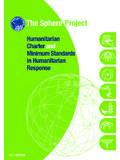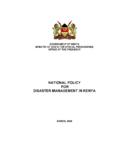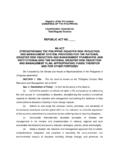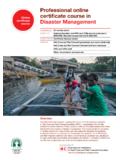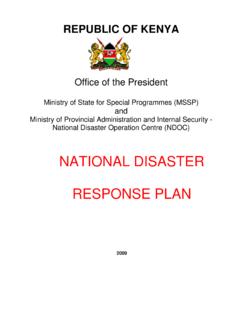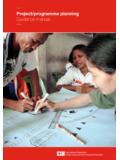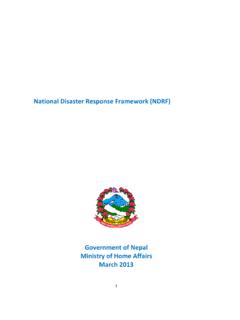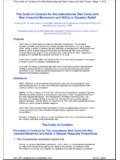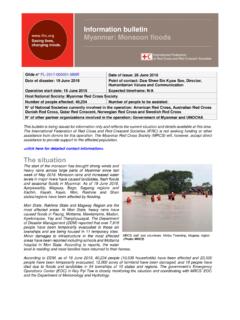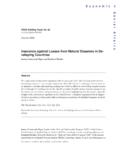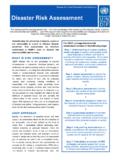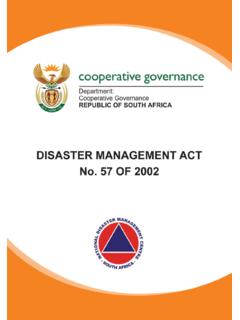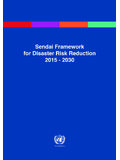Transcription of Community early warning systems: guiding …
1 Lives, changing early warning systems: guiding principles International Federation of Red Cross and Red Crescent Societies, Geneva, 2012 Copies of all or part of this study may be made for non-commercial use, providing the source is acknowledged The IFRC would appreciate receiving details of its use. Requests for commercial reproduction should be directed to the IFRC at photos used in this guidelines are copyright of the IFRC unless otherwise indicated. Cover photo (from left to right, clockwise): Julie Lorenzen/Danish Red Cross; American Red Cross; IFRC. Graphs, courtesy of Leslie Caro Morini Box 372CH-1211 Geneva 19 SwitzerlandTelephone: +41 22 730 4222 Telefax: +41 22 733 0395E-mail: site: early warning systems: guiding principles 1227800 E 1,500 01/2013 The International Federation of Red Cross and Red Cres-cent Societies (IFRC) is the world s largest volunteer-based humanitarian network, reaching 150 million people each year through our 187 member National Societies.
2 Togeth-er, we act before, during and after disasters and health emergencies to meet the needs and improve the lives of vulnerable people. We do so with impartiality as to na-tionality, race, gender, religious beliefs, class and political by Strategy 2020 our collective plan of action to tackle the major humanitarian and development chal-lenges of this decade we are committed to saving lives and changing minds .Our strength lies in our volunteer network, our communi-ty-based expertise and our independence and neutrality. We work to improve humanitarian standards, as partners in development and in response to disasters. We per-suade decision-makers to act at all times in the interests of vulnerable people. The result: we enable healthy and safe communities, reduce vulnerabilities, strengthen re-silience and foster a culture of peace around the early warning systems: guiding principlesStrategy 2020 voices the collective determination of the IFRC to move forward in tackling the major challenges that confront humanity in the next decade.
3 Informed by the needs and vulnerabilities of the diverse communities with whom we work, as well as the basic rights and freedoms to which all are entitled, this strategy seeks to benefit all who look to Red Cross Red Crescent to help to build a more humane, dignified, and peaceful the next ten years, the collective focus of the IFRC will be on achieving the following strategic aims:1. Save lives, protect livelihoods, and strengthen recovery from disasters and crises 2. Enable healthy and safe living 3. Promote social inclusion and a culture of non-violence and peace2 International Federation of Red Cross and Red Crescent SocietiesCommunity early warning systems: guiding principlesTable of contentsAcknowledgments 4 Foreword 5 Acronyms 6 Glossary 7 Introduction to Community early warning systems: guiding principles 91.
4 Background and aims 92. Audience: for whom is the guide written? 103. Methodology 104. Organization 10A. Understanding early warning systems 131. Definitions and concepts 132. Introduction to the four core early warning system components 153. Dispelling early warning myths 164. Political and legal international frameworks for early warning 185. Institutional frameworks for early warning 19B. Cross-cutting themes: guiding principles 25 guiding principle 1: Integrate within DRR EWS is not a stand-alone 25 guiding principle 2: Aim for synergy across levels: Community ,national and regional/global 26 guiding principle 3: Insist on multi-hazard EWS 28 guiding principle 4: Systematically include vulnerability 29 guiding principle 5: Design EWS components with multiple functions 31 guiding principle 6: Accommodate multiple timescales 32 guiding principle 7: Embrace multiple knowledge systems 34 guiding principle 8: Account for evolving risk and rising uncertainty 35 guiding principle 9: EWS without borders: target the full vulnerability and hazard-scape 38 guiding principle 10: Demand appropriate technology 39 guiding principle 11: Require redundancy in indicators and communication channels 41 guiding principle 12: Target and reach disadvantaged and vulnerable groups 43 guiding principle 13.
5 Build partnership and individual engagement 45 International Federation of Red Cross and Red Crescent SocietiesCommunity early warning systems: guiding principles3C. Community -level practice: guiding principles per EWS component 51 Risk knowledge 51 guiding principle K-1 Although risk knowledge exercises may not lead to early warning , all early warning must be founded on risk knowledge 53 guiding principle K-2 Accept that a Community s priorities may not be your own 53 Monitoring 54 guiding principle M-1 Passive receivers of information do not save lives 56 guiding principle M-2 Some communities will need to DRIVE their EWS 58 guiding principle M-3 Public displays of monitoring can motivate communities 59 guiding principle M-4 When hazards evolve, so must their monitoring 60 Response capability 61 guiding principle R-1 In EWS, we respond to warnings .
6 Not to disasters 61 guiding principle R-2 Strive to organize robust no-regrets response actions 63 guiding principle R-3 Embed response options in annually updating contingency plans with links to funding 64 guiding principle R-4 Practice makes perfect: test-drive your response actions 66 warning Communication 67 guiding principle C-1 Clearly delegate responsibility to alert or mediate 68 guiding principle C-2 Do not fall into the sophistication trap for warning devices 71 guiding principle C-3 Use staged warnings (levels and colours) in dissemination 72D. Operational Aspects of EWS and CEWS 75 Annexes 79 Annex 1: Full list of guiding principles 79 Annex 2: List of good practices by zone/country 80 International Federation of Red Cross and Red Crescent SocietiesCommunity early warning systems: guiding principles4 AcknowledgmentsCommunity early warning systems: guiding principles is the result of extensive consultation and valuable contributions from the National Societies, Red Cross Red Crescent Reference Centres and the International Federation of Red Cross and Red Crescent Societies.
7 In addition, a number of lessons learned and good practices were contributed by international and national partners across the globe; this has enabled the guidelines to reflect a more holistic perspective on Community early warning systems. This document benefited greatly from the recommendations provided by the World Meteorological Organization. The guiding principles were made possible through the financial support received from the Norwegian Red Federation of Red Cross and Red Crescent SocietiesCommunity early warning systems: guiding principles5 ForewordThe decline in human and material losses from disasters over the past 30 years is partly due to improved early - warning systems, many of them 'high-tech'. Scientific advances have revolutionized forecasting and the communications technology used for warnings . The International Federation of the Red Cross and Red Crescent Societies advocates, however, for a more people-centred approach that is essential to ensure information and warnings captured by satellites, computer modelling and other technologies reach the most vulnerable communities, who can then act on them.
8 early warnings alone do not keep hazards from turning into action, covering all time scales, is also essential. It is an investment in the future, and has been proven effective at attenuating the effects of disasters. Across the world, significant efforts are being invested in empowering volunteers to take an active role in monitoring risks that influence their communities. As they do so, they learn to both issue, and respond to, warnings that arise from the monitoring. Where and when national early warning systems are active, these Community early warning systems complement governmental mandates to protect lives and livelihoods. Where they do not yet exist, Community early warning systems also serve to catalyze dialogue about what national systems are required and how the National Red Cross and Red Crescent Societies, as auxiliary to governments, may play a role in supporting them. The people-centred approach to early warning , promoted by the Hyogo Framework for Action, focuses on how communities must understand threats in order to avoid them.
9 Disasters are partly caused by external hazards, but they also stem from vulnerability: people being in the wrong place, at the wrong time, or without adequate protection or resources to respond to a warning . There is a consensus that communities must, at the very least, be active receivers of information, while some may even need to be engaged in monitoring so as to facilitate their adoption of protective actions. However, factors as diverse as knowledge, power, culture, environment, lifestyle and personality often determine whether people heed warnings . By engaging communities in the development of the early warning systems from the beginning many of these challenges can be addressed. The present guiding principles of Community early warning systems is a living document that launches a process to compile and capitalize on a rich and growing body of evidence and effort. It gains value by highlighting efforts underway from more than 50 countries across the world, both inside the International Red Cross and Red Crescent Movement and alongside it, through key partners.
10 It is meant as a starting point from which to catalyze a Community of practice in Community early warning systems. It is our hope that readers will contribute to this dialogue, actively sharing additional examples of good practice and lessons learned. Bekele GeletaSecretary GeneralInternational Federation of Red Cross and Red Crescent SocietiesInternational Federation of Red Cross and Red Crescent SocietiesCommunity early warning systems: guiding principles6 AcronymsCEWS Community early warning systemDREF Disaster Relief Emergency FundDRR Disaster risk reductionEWS early warning system IFRC International Federation of Red Cross and Red Crescent SocietiesIGA Income generating activityNGO Non-governmental organizationR ATS Response across time scalesVCA Vulnerability and capacity assessmentInternational Federation of Red Cross and Red Crescent SocietiesCommunity early warning systems: guiding principles7 GlossaryDisaster A serious disruption of the functioning of a Community or a society involving widespread human, material, economic or environmental losses and impacts that exceed the ability of the affected Community or society to cope using its own risk reduction The concept and practice of reducing disaster risks through systematic efforts to analyse and manage the causal factors of disasters, including through reduced exposure to hazards, reduced vulnerability of people and property, wise management of land and the environment, and improved preparedness for adverse A dangerous phenomenon, substance, human activity or condition that may cause loss of life, injury or other health impacts, property damage, loss of livelihoods and services, social and economic disruption, or environmental warning system The set of capacities needed to generate and disseminate timely and meaningful warning information to enable individuals.
